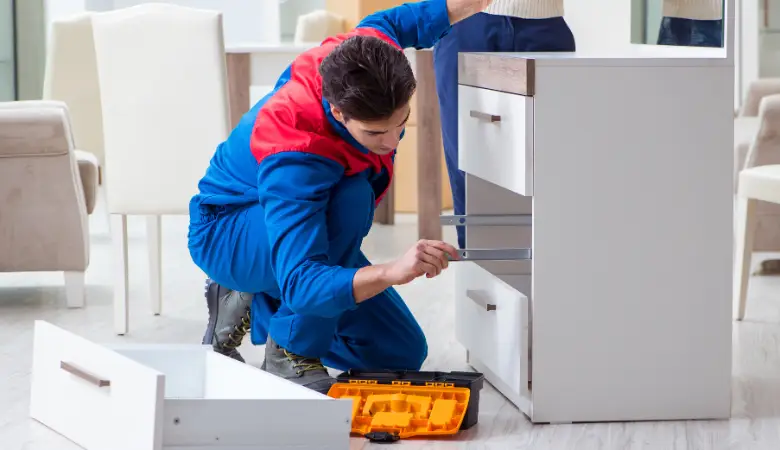
A quality inspection report for furniture provides a detailed evaluation of products to ensure safety, durability, and compliance with industry standards. Manufacturers, buyers, and quality managers use this report to confirm that furniture meets strict quality requirements. The inspection process covers many aspects, including material checks, assembly, and finish. Regular inspections help maintain high quality in both residential and hospitality settings. In the hospitality industry, strong quality control protects guests and supports a positive reputation for hotels and restaurants.
Key Takeaways
• A quality inspection report ensures furniture meets safety, durability, and industry standards before delivery.
• Inspectors follow a detailed process including item selection, packaging review, conformity checks, testing, and workmanship review.
• Clear documentation and communication of inspection results help manufacturers fix issues and improve product quality.
• Hospitality furniture requires extra durability and compliance checks to protect guests and maintain a good reputation.
• Regular inspections reduce defects, support legal compliance, and increase customer satisfaction in both residential and commercial settings.
Quality inspection report for furniture overview
Purpose and scope
A quality inspection report for furniture serves as a structured document that records the results of inspections. This report aims to verify that furniture meets defined quality standards and complies with safety regulations. Manufacturers, buyers, and quality managers rely on these reports to ensure that every piece of furniture aligns with expectations for durability, safety, and appearance. The scope of a quality inspection report for furniture covers all stages of production, from raw materials to finished products. It supports quality assurance by identifying issues early and guiding corrective actions.
Key components
A comprehensive quality inspection report for furniture includes several essential elements:
• Product identification: Details about the furniture, such as model, type, and batch number.
• Inspection criteria: Specific requirements for quality, including measurements, finish, and assembly.
• Quality control checklist: A list of checkpoints for inspectors to follow during evaluations.
• Safety and compliance: Verification that the furniture meets legal and industry standards.
• Materials assessment: Checks on the quality and suitability of materials used.
• Packaging review: Evaluation of packaging to ensure protection during transport.
• Defect documentation: Records of any non-conformities or defects found during inspections.
A well-structured quality control checklist helps inspectors maintain consistency and thoroughness throughout the inspection process.
Industry standards
Industry standards play a vital role in shaping the quality inspection report for furniture. Inspectors reference national and international regulations to ensure compliance. Common standards include ISO 9001 for quality management systems and EN 12520 for strength, durability, and safety of domestic seating. Compliance with these standards guarantees that high-quality furnishings meet customer expectations and legal requirements. Inspections also address environmental and fire safety regulations, which are critical for both residential and commercial furniture.
Inspection process steps
A thorough inspection process ensures that furniture meets strict quality standards before reaching customers. Each step in the process plays a vital role in confirming the safety, durability, and appearance of the final product.
Item selection
Inspectors begin by selecting items for evaluation. They choose samples from different batches to represent the entire production lot. This approach helps identify any inconsistencies in quality. The process of material selection and inspection starts here. Inspectors check that the chosen furniture pieces match the required specifications. They look for variations in color, size, and finish. Accurate item selection forms the foundation for a reliable final product inspection.
Tip: Random sampling increases the chances of detecting hidden defects and ensures a fair assessment of overall quality.
Packaging and labeling
Proper packaging protects furniture during transport and storage. Inspectors review packaging materials to confirm they provide adequate protection against moisture, impact, and dust. They also check that all labels contain correct information, such as product codes, handling instructions, and safety warnings. Packaging tests may include drop tests or compression tests to evaluate durability. A quality control checklist guides inspectors through each packaging checkpoint. Well-labeled and secure packaging reduces the risk of damage and ensures compliance with shipping regulations.
Conformity checks
Conformity checks verify that furniture meets all specified requirements. Inspectors compare each item against the quality control checklist. They measure dimensions, assess finishes, and confirm that all parts are present. These checks ensure that the furniture aligns with design drawings and customer expectations. Inspectors also review documentation to confirm compliance with industry standards. Comprehensive conformity checks help prevent costly errors and support a smooth final product inspection.
On-site and lab testing
On-site and laboratory testing provide deeper insights into furniture quality. Inspectors perform functional and visual checks at the production site. They test moving parts, such as drawers and hinges, for smooth operation. Lab testing may include durability and performance testing, where furniture undergoes stress tests to evaluate strength and longevity. Inspectors use advanced technology, such as AI-powered tools and real-time reporting systems, to collect accurate data. These tests confirm that materials meet safety and durability requirements.
Note: Combining on-site and lab testing offers a complete view of product performance and helps identify potential weaknesses early.
Workmanship review
The final step involves a detailed workmanship review. Inspectors examine the assembly, joints, and finishes for defects. They look for issues like loose screws, uneven surfaces, or poor paint application. This review ensures that the final product inspection covers every aspect of construction. Inspectors document their findings and take photos for reference. Consistent documentation at each stage supports traceability and accountability. High-quality workmanship increases customer satisfaction and extends the life of the furniture.
A well-structured inspection process, supported by comprehensive checklists and accurate documentation, guarantees that furniture meets the highest standards for quality, durability, and safety.
Final product inspection and reporting
Documentation
Final product inspection serves as the last checkpoint before furniture reaches customers. Inspectors review each piece to confirm it meets all quality standards. They examine packaging to ensure it protects the furniture during shipping. Safety tests, such as stability and load-bearing checks, help verify that the furniture is safe for use. Inspectors record their findings in detailed reports. These documents include photographs, measurements, and notes about any issues. Accurate documentation supports traceability and helps manufacturers improve future production.
Tip: Clear and organized documentation makes it easier to track trends in quality and address recurring problems.
Communication of results
After completing the final product inspection, inspectors share their results with all stakeholders. They use clear language and visual evidence to explain their findings. Reports often include tables that summarize key points, such as the number of defects or areas that passed inspection. This information helps managers make informed decisions about shipping or holding back furniture. Effective communication ensures that everyone understands the current quality status and any actions needed.
| Inspection Area | Result | Notes |
|---|---|---|
| Packaging Quality | Pass | No damage observed |
| Safety Tests | Pass | Stable and secure |
| Visual Inspection | Minor Issue | Small paint scratch |
Addressing non-conformities
When inspectors find non-conformities during the final product inspection, they document each issue in detail. They describe the problem, its location, and possible causes. The team then decides on corrective actions, such as repairs or additional testing. Addressing non-conformities quickly helps maintain high quality and prevents defective furniture from reaching customers. Regular reviews of inspection data also help identify patterns and reduce future defects.
Note: Timely action on non-conformities protects the reputation of manufacturers and ensures customer satisfaction.
Hospitality furniture quality control
Compliance requirements
Hospitality furniture quality control plays a critical role in the hotel and restaurant industry. Hospitality spaces demand furniture that meets strict safety and durability standards. Inspectors check each piece for compliance with fire safety, environmental, and structural regulations. Quality hotel furniture must pass tests for stability and load-bearing capacity. Inspectors verify that all materials used in hospitality furniture meet local and international compliance requirements. They also review documentation to ensure that every item aligns with legal standards. Consistent inspection helps hotels and restaurants avoid penalties and maintain a safe environment for guests.
Tip: Regular compliance checks reduce the risk of accidents and support a positive reputation for hospitality businesses.
Special considerations
Hospitality furniture faces heavy use in public spaces. Quality hotel furniture must withstand frequent movement, cleaning, and exposure to different conditions. Durability becomes a top priority in hospitality furniture quality control. Inspectors look for strong joints, reinforced frames, and finishes that resist scratches and stains. They also assess comfort and appearance, as both factors influence guest satisfaction. In commercial spaces, furniture must support a variety of uses, from dining to lounging. Hospitality furniture quality control includes detailed inspection of assembly, materials, and workmanship. Inspectors use checklists to ensure that every aspect of the furniture meets high standards for quality and durability.
• Key points for hospitality furniture quality control:
◦ Durability testing for long-term use
◦ Safety checks for guest protection
◦ Compliance with fire and environmental regulations
◦ Inspection of finishes and materials for easy maintenance
A strong hospitality furniture quality control process ensures that hotels, restaurants, and commercial venues provide safe, attractive, and reliable environments for guests.
A thorough quality inspection report improves furniture quality and reduces defects. Inspectors help manufacturers deliver safe and reliable furniture to hospitality businesses. Each inspection step supports compliance with industry standards. Hospitality managers depend on these reports to protect guests and maintain high standards. Regular inspections in hospitality settings ensure furniture remains durable and attractive. Companies that use detailed inspection processes see better results and higher customer satisfaction.
FAQ
What is the main purpose of a furniture quality inspection report?
A furniture quality inspection report helps ensure that products meet safety, durability, and compliance standards. It provides clear documentation for manufacturers, buyers, and quality managers to verify product quality before delivery.
Who uses furniture quality inspection reports?
Manufacturers, buyers, and quality managers use these reports. They rely on the information to make decisions about production, purchasing, and quality control. Hospitality managers also use them to maintain high standards in hotels and restaurants.
What are common defects found during furniture inspections?
Inspectors often find scratches, loose joints, uneven finishes, or missing hardware. They may also notice problems with packaging or labeling. Early detection of these issues helps prevent defective products from reaching customers.
How do inspectors test furniture durability?
Inspectors perform stress tests, load-bearing checks, and stability assessments. They may use machines or manual methods to simulate real-life use. These tests help confirm that furniture can withstand daily wear and tear.
Why is compliance important in hospitality furniture?
Compliance ensures that furniture meets safety and legal requirements. It protects guests and staff in hotels and restaurants. Regular compliance checks also help businesses avoid fines and maintain a positive reputation.
Grow your business with TradeAider Service
Click the button below to directly enter the TradeAider Service System. The simple steps from booking and payment to receiving reports are easy to operate.

.png)

